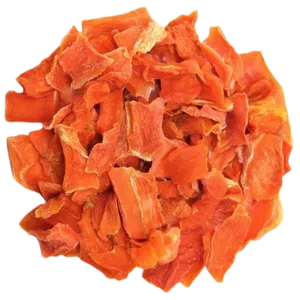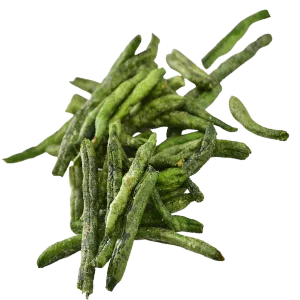With today’s economy and supply chain issues, it’s more important than ever to keep your family’s pantry well stocked with healthy foods in times of need. Keeping large quantities of fresh or frozen produce isn’t easy.
Fresh produce has a short shelf life, and frozen takes up a lot of freezer space.
Fortunately, there is another option for you that gives you the freedom to take advantage of bulk discount opportunities of both fresh and frozen produce.
How, you ask? Dehydration!
Dehydrating foods provide longer shelf life and take up less space, while providing your family with healthy food year round. But before you get overwhelmed or assume it’s too time-consuming and costly, please read to the end, where I’ve included a couple helpful real-world pricing examples.
Here is a list of foods you should consider dehydrating and the directions on how to do it. The directions are for using an electric dehydrator, but you can also use your oven. The benefit of a dehydrator is the steady temperature control, which is important for the best results.
You can start with an inexpensive dehydrator and upgrade when you are ready. The times given for each foods’ dehydration time will depend on the thickness and size of the pieces, just check periodically for doneness.
Make sure that the pieces don’t overlap or touch when arranging on the trays.
Dehydrated foods should be stored in an airtight container or bag.
Vegetables
Dehydrated vegetables are easy to add to soups, stews, pasta dishes and casseroles. Of course, they can also be eaten as is as a healthy snack.
And dehydrating your surplus homegrown vegetables will reduce your family’s food waste to almost zero!

Carrots
You can use fresh or frozen. When using frozen, thaw first and cut into smaller pieces if desired. For fresh, wash and peel (you can keep the skin on if you like). Place whole carrots into boiling water for 5 minutes, remove from water and place in a bowl of cold water and then drain. Slice into thin, even slices or small dices, then place in an even layer on the trays and set temperature to 135 degrees F for 6-12 hours. Place in an airtight container and store in a cool, dry place.
Potatoes
Wash the potatoes. You can choose to leave unpeeled or remove them. Place whole potatoes in boiling water for 20 minutes, let cool and then slice into ⅜ inch thick slices or dice into similar sized pieces or shred. Place in an even layer on parchment paper lined trays. Set temperature to 135 degrees F for 5-14 hours.

Corn
You can use fresh or frozen. When using frozen, thaw first. For fresh, you will need to remove husk and silk, then place cobs into boiling water for 10 minutes, then place in a sink of cold water. Remove the kernels from the cob and place in an even layer on the trays and set temperature to 135 degrees F for 6-12 hours.
Sweet Potatoes
Wash and peel the sweet potatoes, then slice into ⅜ inch thick slices, dice into small similar sized cubes or shred. To remove the raw taste, place into boiling water or steam for 2-3 minutes, then place in a bowl of cool water, and then drain. You can also bake the sweet potatoes at 30 degrees F for 20 minutes and then slice, dice or shred. This will give you a great flavor, but by baking them they will lose some of their nutritional value. Place in an even layer on trays lined with parchment paper. Set the temperature to 125 degrees F for 8-12 hours.

Broccoli
You can use fresh or frozen. When using frozen, thaw first For fresh, cut the broccoli into similar sized pieces. Then place in boiling water for 2 minutes, then place in a bowl of cool water and then drain. Place in an even layer on the trays. Set temperature to 135 degrees F for 6-14 hours.
Winter Squash
Cut the squash in half, remove the seeds and peel. Slice into ⅜ inch thick slices or dice into similar sized cubes. Steam until tender (but not mushy), then place in a bowl of cool water and then drain. Place in even layer on trays. Set the temperature to 135 degrees F for about 8 hours.

Cauliflower
You can use fresh or frozen. When using frozen, thaw first. For fresh, cut the cauliflower into similar sized pieces and place in boiling water for 2 minutes, then place in a bowl of cool water and then drain. Place in an even layer on the trays. Set temperature to 135 degrees F for 6-14 hours.
Peppers
Cut the peppers in half and remove the seeds and veins, then slice into strips, discs or diced. For hot peppers, you can choose to leave the seeds and veins for added heat. Place in even layer on trays. Set the temperature to 145 degrees F for up to 6 hours. You will need to check every hour or so to see if done.

Green Beans
You can use fresh or frozen. When using frozen, let thaw first. For fresh, remove ends and cut into equal sized pieces, then blanch in boiling water for 3 minutes, then place in a bowl of cool water and then drain. Place in an even layer on trays. Set temperature to 135 degrees for 6-8 hours.
Onions
Remove the ends and skins. Slice into thin slices or dice into similar sized pieces. Separate the rings and dices into individual pieces. Place on trays in an even layer. Set temperature 135 degrees F for 10-18 hours. Dehydrated onions can be ground into a powder for use as a seasoning. Due to the strong onion odor, you might consider placing the dehydrator in the garage for this use.

Peas
You can use fresh or frozen. When using frozen, let thaw first. For fresh, remove from shell and lightly steam for 5-10 minutes, then place in a bowl of cool water and then drain. Place in an even layer on trays. Set temperature to 135 degrees F for 5-14 hours.
Celery
Remove leaves, and slice into thin, even slices on parchment paper lined trays. Set the temperature to 125 degrees F for 4-8 hours. Celery should be dry and brittle when done.

Tomatoes
Wash the tomatoes. You can choose to leave unpeeled or remove them. Slice the tomatoes into ¾ inch slices or dice into similar sized pieces and place in an even layer on trays. Set temperature to 125-135 degrees F for 5-12 hours.
Garlic
Separate and peel the cloves, then slice into thin, even slices (using a mandolin will make this step easier). Place slices in a thin, even layer on parchment paper lined trays. Set temperature to 135 degrees F for 6-12 hours. Dehydrated garlic can be ground into a powder to use as a seasoning. Due to the strong garlic odor, you might consider placing the dehydrator in the garage for this use.

Zucchini
Wash and remove the ends. Slice into ⅜ inch thick slices and place in an even layer on trays. Set temperature to 135 degrees F for 5-11 hours.
Mushrooms
Gently brush dirt off using a soft cloth, then slice into ¼ inch slices. Place in an even layer on trays. Set temperature to 125 degrees F for 3-8 hours.
Dehydrating Vegetables Cheatsheet
Fruits
Dehydrated fruits make a great healthy snack, but they can also be added to cereal, oatmeal, yogurt, and baked goods. It’s best to choose fruits that aren’t overripe, be sure they aren’t mushy.

Apples
Wash apples, you can choose to remove the peels or leave them on. Remove the core and slice into ⅓ inch thick slices, then place into a bowl of ½ lemon juice ½ water or citric acid and water. Remove slices and place slices in even layer on trays. Set temperature to 135 degrees F for 4-10 hours. Try lightly sprinkling some cinnamon or apple pie spice onto slices before dehydrating for a tasty flavor change.
Bananas
Peel and slice into ¼ inch slices, then place into a bowl of ½ lemon juice ½ water or citric acid and water. Remove slices and place in an even layer on trays. Set temperature to 135 degrees F for 6-12 hours. Try lightly sprinkling some cinnamon onto the slices before dehydrating for a tasty flavor change. Strawberries: You can use fresh or frozen, but you will get the best results with fresh. When using frozen, thaw first. For fresh, wash and remove tops, then slice into ¼ inch slices. Place on trays in an even layer. Set temperature to 135 degrees F for 6-15 hours.

Blueberries
You can use fresh or frozen. When using frozen, thaw first. For fresh, place blueberries in a pot of boiling water for 30 seconds to break the skin, this will make the drying process more effective, take out of boiling water and place into a bowl of cold water. Place in an even layer on trays. Set temperature to 135 degrees F for 10-18 hours.
Blackberries/Raspberries
You can use fresh or frozen, but you will get better results with fresh. When using frozen, let thaw first. For fresh, no other step is needed. Place in an even layer on trays. Set temperature to 135 degrees F for 10-18 hours.

Grapes
Wash the grapes and place in a pot of boiling water for 30 seconds to break the skin, this will make the drying process more effective, take out of boiling water and place into a bowl of cool water. Cut grapes in half. Place grape halves in an even layer on trays. Set temperature to 135 degrees F for 6-10 hours.
Pears
You can choose to leave the peels on or remove them, quarter the pears and remove the core, then slice in ⅓ inch thick slices. Place slices in a bowl of ½ lemon juice and ½ water or citric acid and water. Remove and place in an even layer on parchment lined trays. Set temperature to 135 degrees F for 6-16 hours.

Peaches
Can use fresh or frozen. When using frozen, thaw first. For fresh, slice in half and remove the pit. Slice in ⅓ inch slices and place in a bowl of ½ lemon juice and ½ water or citric acid and water. Remove and place in an even layer on trays. Set temperature to 135 degrees F for 6-24 hours.
Kiwi
Peel and slice into ¼ inch slices. Place in an even layer on trays. Set temperature to 135 degrees F for 10-18 hours.

Citrus
Slice into thin, even slices and remove any seeds. Place in an even layer on trays. Set temperature to 135 degrees F for 2-12 hours. Slices should be dry and brittle when fully done.
Apricots
Slice in ½ and remove the pit, then slice into ⅓ inch slices, and place in a bowl of ½ lemon juice and ½ water or citric acid and water. Place in an even layer on trays. Set temperature to 135-145 degrees F for 12-14 hours.

Pineapple
Cut, peel and core the pineapple. Cut into ⅓ inch thick, small pieces. Place in an even layer on trays. Set temperature to 135 degrees F for 8-16 hours.
Cherries
Cut in half and remove pit. Place in an even layer on trays. Set temperature to 135 degrees F for 6-10 hours.

Mango
Cut in half and remove seed, then peel and slice into ⅓ inch spears or chunks. Place in a bowl of ½ lemon juice and ½ water or citric acid and water. Remove and place in an even layer on trays. Set temperature to 135 degrees F for up to 9 hours.
Papaya
Cut in half and remove seeds and peel. Cut into ¼ inch thick spears or chunks and place into a bowl of ½ lemon juice and ½ water or citric acid and water. Set temperature to 135 degrees F for 7-15 hours.
Dehydrating Popular Fruits Cheatsheet
Dehydrating Herbs
Dehydrating fresh or homegrown herbs is an easy way to enjoy your favorites in any recipe. You can make your own seasoning blends too. And, who knows, if your own homemade herbal blends are a hit, you just may have a nice side hustle on your hands!
To dehydrate your fresh herbs, remove leaves from the stems, and place on a mesh tray screen or line the tray with parchment paper in an even layer.
Set temperature to 95-115 degrees F for 1–4 hours. The length of dehydrating time will depend on the size of the herbs you are drying.
Be sure to keep a close eye on them to make sure they don’t get overdone.
Dehydrating Beans
Beans are an inexpensive staple for any family, but we all know it takes a little time to soak and cook them, this makes last minutes use difficult.
Cooking your beans in large batches and dehydrating them will be an awesome time saver and an easy go to ingredient for many recipes.
When cooking your beans, be sure to not overcook your beans, it’s best to cook them until they are tender but not mushy.
To dehydrate your cooked beans, place them in an even layer on trays. Set temperature to 125 degrees F for 6–12 hours.
The drying time will vary depending on the size of the beans.
Dehydrating Cooked Grains and Rice
Whole grains (or even better, ancient grains) and rice are always a great, inexpensive (especially when bought in bulk) additions to any meal of the day, but their cooking time can make it a difficult task for anyone on the go.
The best way to be able to enjoy your favorite grains and rice anytime is to cook them in large batches and dehydrate them.
When cooking your grains, be sure not to overcook them, they shouldn’t be mushy.
Place the cooked grains on parchment paper lined trays in an even, thin layer. Set temperature to 130 degrees F for up to 6 hours.
The drying time will vary depending on the thickness of the grains.
Comparing Prices of Homemade Versus Store Bought Dehydrated Fruits
Dehydrating foods is a great way to gather a strong stock of healthy foods for your family to enjoy.
You can stock up when you can purchase at the best time and price for your family’s favorites, and you will know that your dried foods don’t contain any of the artificial colors, flavors, preservatives or other additives that a lot of the prepacked packages available at the grocery stores contain, and you won’t have to pay the high prices either.
A few price comparisons are provided below to show you how much money dehydrating at home can save you.
You can have peace of mind knowing that your family will have foods available during difficult times.

As you begin your journey into lower your overall food waste (thanks for that!) and food dehydrator, please keep in mind that not all food should be dehydrator.
In fact, here’s a handy quick list of the eight major food items you should never dehydrate and why.















